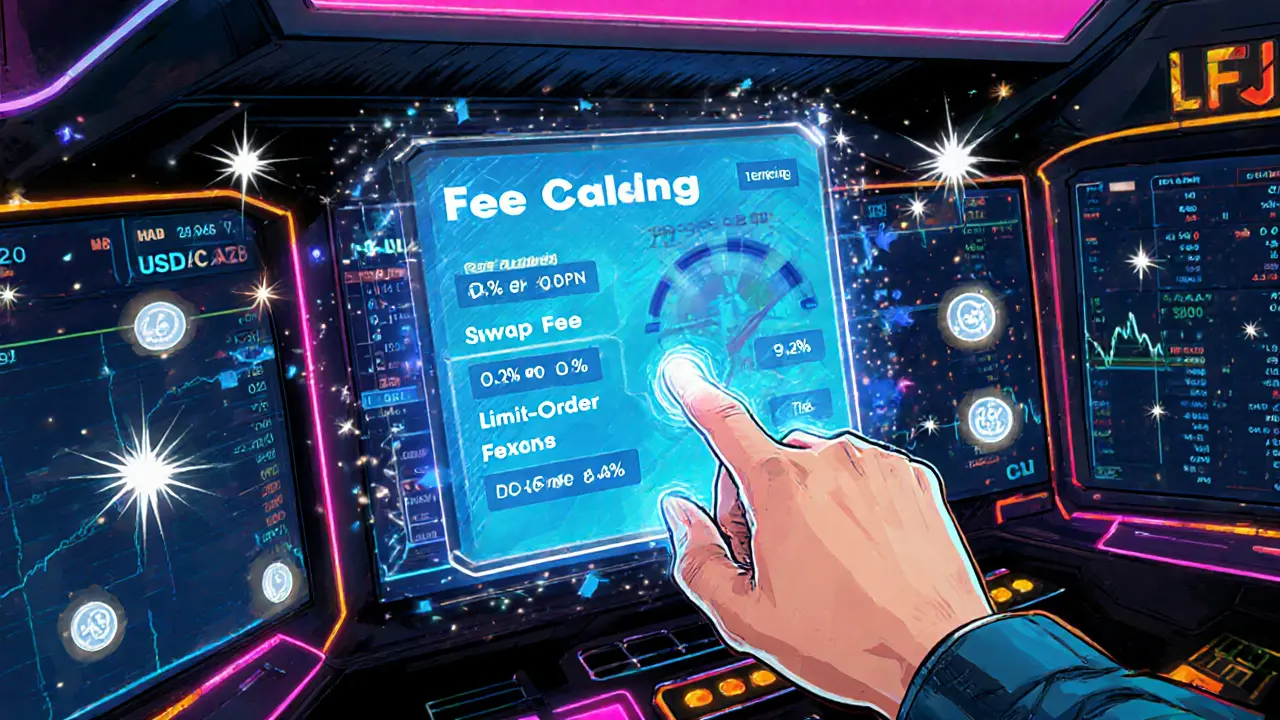- Home
- Cryptocurrency
- LFJ v2 (Arbitrum) Review: Fast, Low‑Fee DEX from TraderJoe

LFJ v2 (Arbitrum) Review: Fast, Low‑Fee DEX from TraderJoe
LFJ V2 (Arbitrum) Fee Calculator
Trading Fee Estimator
Estimate the fees you'll pay when trading on LFJ V2 (Arbitrum). Enter your trade details below:
Estimated Trading Costs
Enter trade details and click "Calculate Fees" to see estimated costs.
About LFJ V2 (Arbitrum) Fees
LFJ V2 (Arbitrum) charges:
- 0.3% swap fee for standard trades
- 0.2% limit order fee for limit orders
These fees are significantly lower than many other DEXs and benefit from Arbitrum's low gas costs.
When you see LFJ V2 (Arbitrum) is a decentralized exchange built on the Arbitrum layer‑2 solution and tied to the TraderJoe ecosystem. you’ve got a niche DEX that promises Ethereum‑level security with the speed and cheap fees of a roll‑up. Launched in 2023, it’s the second‑generation branch of the original TraderJoe platform that started on Avalanche. Below you’ll find a straight‑to‑the‑point review that covers everything a trader needs to know before jumping in.
Quick Takeaways
- Runs on Arbitrum, so gas costs are a fraction of Ethereum mainnet.
- Spot‑only trading, no margin or leverage.
- Flat 0.3% swap fee and 0.2% limit‑order fee - competitive for a DEX.
- Only 2 coins and 4 pairs available today - very limited selection.
- No KYC, wallet‑only access; supports MetaMask, Core, Trust Wallet.
What is LFJ V2 (Arbitrum)?
The platform is essentially a trimmed‑down version of the original Trader Joe a leading DeFi hub on Avalanche. While TraderJoe on Avalanche lists over a thousand tokens, LFJ V2 (Arbitrum) currently showcases just two native assets - USDC and ARB - creating four tradable pairs. The design mirrors the familiar TraderJoe UI, making the switch painless for existing community members.
How to Start Trading
- Install a supported wallet. MetaMask a browser‑extension wallet compatible with Ethereum and its L2s is the most common, but Core and Trust Wallet work as well.
- Switch the network to Arbitrum. If you don’t have ARB for gas, bridge some ETH from the Ethereum mainnet using the official Arbitrum Bridge.
- Visit the LFJ V2 (Arbitrum) site and click “Connect Wallet”. Approve the connection request in your wallet.
- Select a pair, enter the amount, and confirm. The transaction settles in seconds, and you retain full custody of your tokens.
- To place a limit order, navigate to the “Limit” tab, set price, and sign the order. Your order lives on‑chain until filled or cancelled.

Fees and Liquidity
LFJ V2 (Arbitrum) mirrors the fee model of its parent platform: 0.3% on swaps and 0.2% on limit orders. These rates sit comfortably under UniswapV3’s typical 0.3%‑0.5% range on the same layer‑2.
Liquidity is modest. Data from CoinGecko a crypto market data aggregator (2023 snapshot) shows an average bid‑ask spread of 0.686% and placement in the 42nd percentile for volume among Arbitrum DEXs. For high‑volume traders, the thin orderbook can cause slippage, but casual users generally find the spreads acceptable.
Strengths & Weaknesses
| Aspect | Pros | Cons |
|---|---|---|
| Speed & Cost | Arbitrum’s roll‑up delivers sub‑$0.01 gas fees and sub‑second finality. | Dependent on Arbitrum’s network health; occasional congestion spikes. |
| Security | Inherits Ethereum’s security model via fraud proofs. | No additional audit reports specific to the Arbitrum branch yet. |
| Asset Range | Focused offering reduces complexity for new users. | Only 2 coins/4 pairs limits diversification. |
| Regulatory | No KYC - instant onboarding. | Restricted in 20+ jurisdictions, including US and China. |
| Community | Leverages TraderJoe’s active Discord and support desk. | Arbitrum‑specific resources are thin; most docs target Avalanche. |
Comparison with Other Arbitrum DEXs
| Feature | LFJ V2 (Arbitrum) | Uniswap V3 (Arbitrum) | GMX (Arbitrum) |
|---|---|---|---|
| Asset Count | 2 coins / 4 pairs | ~200 tokens | 12 major assets (leveraged) |
| Swap Fee | 0.3% | 0.05%‑0.30% (tiered) | 0.20% (plus funding rate) |
| Leverage | No | No | Up to 5× |
| Governance Token | JOE | UNI | GMX |
| KYC | No | No | No |
In short, LFJ V2 (Arbitrum) offers a familiar UI and low fees but falls short on breadth and advanced features compared with Uniswap or GMX. If you value a tight community and plan to stay within the TraderJoe ecosystem, the trade‑off may be worth it.
Future Outlook
Analysts see the Arbitrum ecosystem expanding steadily. The Arbitrum Ethereum’s leading layer‑2 scaling solution network has attracted major protocols, and its native token ARB peaked at $2.4 in early 2024. LFJ V2’s cautious rollout suggests the team is testing demand before committing resources to a full feature parity with Avalanche.
Potential upgrades include:
- Adding more trading pairs - likely popular ERC‑20s and bridge‑wrapped assets.
- Introducing yield‑optimizing services such as staking or liquidity mining.
- Rolling out a native Arbitrum‑specific governance portal tied to the JOE token.
If the platform can broaden its asset list while preserving low fees, it could carve a respectable niche alongside Uniswap and GMX. For now, treat LFJ V2 (Arbitrum) as a beta‑grade DEX that’s solid for simple swaps but not yet a one‑stop shop.

FAQ
Is LFJ V2 (Arbitrum) safe to use?
The exchange inherits Ethereum’s security model via Arbitrum’s fraud‑proof roll‑up. Because it is non‑custodial, you keep full control of your keys. However, the Arbitrum‑specific code has not been audited as extensively as the Avalanche version, so users should start with small amounts.
Which wallets can I connect?
MetaMask, Core, and Trust Wallet are officially supported. Any wallet that can sign transactions on the Arbitrum network will work.
Do I need ARB for gas?
Yes, gas fees on Arbitrum are paid in ETH that is bridged to the layer‑2. Most users bridge a small amount of ETH and then pay <$0.01 per transaction.
Can I earn JOE tokens by trading?
Trading on LFJ V2 does not automatically generate JOE rewards. The main reward mechanisms - staking and liquidity mining - are still exclusive to the Avalanche platform, though the team has hinted at future Arbitrum incentives.
Is there any KYC or account verification?
No. LFJ V2 (Arbitrum) is a permission‑less DEX. You simply connect a wallet and start swapping.
Overall, the LFJ v2 Arbitrum review paints a picture of a trustworthy, low‑fee spot DEX that’s still in its early growth stage. If you’re after quick swaps with minimal friction, it’s worth a try; if you need deep liquidity and a wide token menu, you might stick with Uniswap or wait for the next LFJ update.
Cormac Riverton
I'm a blockchain analyst and private investor specializing in cryptocurrencies and equity markets. I research tokenomics, on-chain data, and market microstructure, and advise startups on exchange listings. I also write practical explainers and strategy notes for retail traders and fund teams. My work blends quantitative analysis with clear storytelling to make complex systems understandable.
Popular Articles
15 Comments
Write a comment Cancel reply
About
DEX Maniac is your hub for blockchain knowledge, cryptocurrencies, and global markets. Explore guides on crypto coins, DeFi, and decentralized exchanges with clear, actionable insights. Compare crypto exchanges, track airdrop opportunities, and follow timely market analysis across crypto and stocks. Stay informed with curated news, tools, and insights for smarter decisions.







LFJ V2 is exactly what Arbitrum needed: simple, cheap, and no nonsense. No leverage, no complexity, just swap USDC for ARB and go. I’ve been using it for two weeks now and haven’t had a single failed tx. Perfect for beginners who don’t want to drown in 500 tokens they don’t understand.
Oh, fantastic-another ‘minimalist’ DEX that’s really just ‘underdeveloped.’ 2 tokens? 4 pairs? That’s not focus-that’s abandonment. And you call this ‘beta-grade’? It’s barely alpha. The team’s clearly waiting for ARB to hit $5 before they bother adding anything else. Meanwhile, Uniswap’s got 200 tokens and a functioning fee tier system. This feels less like innovation and more like a placeholder with a marketing budget.
While I appreciate the intention behind LFJ V2's streamlined approach, I must emphasize that the absence of an independent audit for the Arbitrum-specific smart contracts constitutes a non-trivial risk exposure for users who are not adequately informed. Furthermore, the reliance on a single ecosystem (TraderJoe) without decentralization of governance introduces a centralized point of failure that contradicts the foundational ethos of DeFi. One must question whether convenience is being prioritized over cryptographic integrity.
2 tokens? Only ARB and USDC? That’s not a DEX-it’s a honeypot. They’re just pumping ARB to inflate the token price and then they’ll rug. You think they’d let you trade ETH or WBTC? No. Because then people would see how thin the liquidity really is. They want you to buy ARB with your USDC so they can dump it on you later. Watch the volume drop in 30 days. I’m telling you, this is a front for a token dump.
Don’t let the naysayers scare you off. LFJ V2 is a hidden gem for simple swaps. If you’re not trading 50 different memecoins and just want to move between ARB and USDC without paying $5 in gas, this is it. The UI is clean, the fees are rock bottom, and the TraderJoe team has proven they know what they’re doing. I’ve used this daily for a month-zero issues. Give it time; they’ll add pairs. They’re not lazy, they’re deliberate.
Yessss! 😊 I love how clean this is-no chaos, no noise, just a smooth swap. I used to get overwhelmed on Uniswap with all the tokens, but here? Two coins, two clicks, done. I’ve even convinced my mom to use it (she’s 68 and now swaps ARB for USDC like a pro). Keep it simple, guys. This is what DeFi should feel like sometimes.
The architectural decision to limit asset exposure during the initial launch phase is strategically prudent, particularly when considering liquidity depth and user onboarding friction. The current configuration allows for focused market-making, reduces attack surface, and enables iterative feedback loops. While the feature set may appear constrained, the operational stability and low slippage metrics suggest a maturity that exceeds many competitors with bloated token lists. This is not a limitation-it is a controlled environment for scalable growth.
Bro, you don’t need 200 tokens. You need one good one. ARB is the future. USDC is the anchor. Everything else is noise. If you can’t understand that, you’re not ready for crypto. This is wisdom. Not greed. Simplicity is power.
Of course it’s only two tokens. They’re not dumb enough to let you trade anything that might reveal how little real liquidity they have. This is a front for a private sale dump. JOE token is already overvalued, and now they’re using Arbitrum to lure in the naive. Don’t be fooled by the clean UI-it’s a velvet rope for insiders. Check the whale wallets. You’ll see ARB being moved out faster than it’s being added.
Someone actually thinks this is better than Uniswap? Wow. So now ‘fewer options’ is a feature? That’s like saying a restaurant is better because it only serves bread and water. If you’re not trading ETH, WBTC, or even a decent stablecoin like DAI, you’re not trading-you’re just holding. This isn’t innovation. It’s regression.
0.3% fee? Really? That’s ‘competitive’? Uniswap V3 has 0.05% for high-volume pairs-and you’re calling this ‘cheap’? And you didn’t even mention the fact that JOE tokenomics are a mess-50% of supply is locked in ‘community treasury’ that’s controlled by… who? The same people who made TraderJoe on Avalanche? Sounds like a cozy club. I’ll stick with SushiSwap, thanks.
I’ve been using this for a week now. I don’t trade much, but when I do, I want it to be fast and safe. This is both. I’m not here for leverage or 500 tokens. I just want to swap ARB for USDC without stress. The interface is calm. The transactions are instant. That’s enough for me.
It’s worth noting that the cultural and technical migration from Avalanche to Arbitrum reflects a broader strategic realignment within the DeFi ecosystem, wherein capital and developer attention are increasingly gravitating toward Ethereum Layer 2 solutions due to superior scalability, security guarantees, and institutional adoption trajectories. LFJ V2’s restrained launch is not a sign of weakness-it is a deliberate alignment with the dominant architectural paradigm of the next crypto cycle. The focus on minimalism may appear counterintuitive in a market saturated with feature bloat, but history has shown that sustainable protocols often begin with restraint. This is not a beta-it is a prototype of the future: efficient, secure, and user-centered.
Y’all are overthinking this. I’m a grandma with a phone and a wallet. I don’t need 200 tokens. I just need to swap my ARB for USDC without paying $3 in gas. This works. I told my book club about it. They’re all using it now. Simple is good. Keep it simple.
Low fees, clean UI, no drama. This is what DeFi dreams are made of 🚀💎. I used to hate swapping on Uniswap-too many options, too many scams. Now I just go to LFJ, pick ARB/USDC, click swap, done. No stress. No FUD. Just smooth, cheap, reliable action. They’re gonna add more pairs soon-I can feel it. This is the quiet winner of Arbitrum.